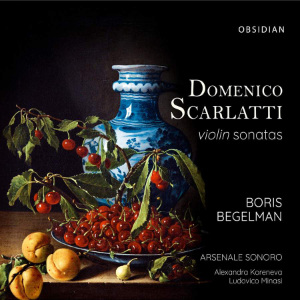
Domenico Scarlatti (1685-1757)
Violin Sonatas
Boris Begelman (violin)
Arsenale Sonoro
rec. 2020, Sala della Carita, Padua, Italy
Obsidian CD720 [68]
In volume 14 of a copy of Domenico Scarlatti’s sonatas (a copy probably made for the composer’s royal student, Maria Barbara of Braganza, daughter of King João V of Portugal), now in the Bibloteca Marciana in Venice, there are several sonatas which are strikingly different from the great majority of Scarlatti’s sonatas. Most obviously, these few sonatas are in several movements – between two and four – whereas most of Scarlatti’s sonatas consist of a single movement. As long ago as 1906, Edward Dent suggested that this group of sonatas were not intended for solo harpsichord, but for violin and harpsichord. Later scholars have pointed out other sonatas that share some of the same characteristics, sometimes containing a figured bass and often written in a way which keeps the ‘right hand voice’ and the ‘left hand voice’ absolutely distinct throughout. In most of these sonatas, the ‘right hand voice’ contains widely spaced chords which are more or less unplayable by a single hand at a keyboard; some of the scoring for the ‘right hand’ contains dots and slurs more suited to a string instrument than to a harpsichord.
On this rewarding disc Boris Begelman and Arsenale Sonoro play 8 such sonatas. The disc also contains performances of two works by Scarlatti senior, a toccata from one of his sets of variations on la folia – ‘Folia moderato’ and his Cello Sonata in D minor (Largo – Allegro – Largo – Tempo giusto).
Though I haven’t studied the relevant manuscript in Venice (and wouldn’t regard myself as a competent judge of its full significance even if I had), I have read a good deal of the relevant scholarly literature and I find the argument that Domenico Scarlatti intended these specific sonatas to be played by violin and harpsichord rather than solo harpsichord very persuasive.
However, if, as the old proverb puts it “the proof of the pudding is in the eating”, then by analogy, one might say that where musicology is concerned “the proof of the scholarship is in the hearing” – and hearing these sonatas played by an insightful virtuoso such as Boris Begelman with the support of an accomplished continuo section, I certainly hear more expressiveness and vivacity than I have heard in even the best solo harpsichord interpretations of these sonatas. The additional colours provided by the violin, as well as the interplay between the plucked strings of the harpsichord and the violin played arco, create dimensions absent from an interpretation on the harpsichord alone.
Boris Begelman’s playing is every bit as fleet and agile as this music sometimes requires, but is also tonally rich and various. He is by turns thoughtful and energetic, being equally capable of tenderness or forcefulness. He and the continuo instruments complement one another perfectly. Though doubtless the product of intelligent rehearsal and long familiarity, the performances of these sonatas all have a very engaging air of spontaneity and mutual pleasure about them, not least when improvised ornaments are executed with a delightful precision that never sounds in the least pedantic.
I have also found much to admire and enjoy in Alexandra Koreneva’s interpretation of Alessandro Scarlatti’s ‘Folia moderato’. Tempi are perfectly judged and the theme’s origins in dance are everywhere remembered. This is playing which displays a delightful flair. I hope to hear more of Koreneva’s solo work soon.
The only slight disappointment on this generally fine disc comes with the Cello Sonata by Alessandro Scarlatti, in which the soloist Ludovico Minasi, is supported by the cello of Cristina Vidoni. While I wouldn’t call this a ‘bad’ performance, heard amongst music-making of such flair and energy, it feels a little on the inert side. The only other recording I have on my shelves is that by Mauro Valli and Paolo Ballanti, members of Ottavio Dantone’s Accademia Bizantina (on ARTS 477588), which has rather more verve. However, my slight reservations about the interpretation of this one work don’t in any way diminish my pleasure in what is in most respects an exciting and accomplished recording.
After graduating from the Moscow Conservatory in 2007, Russian-born Boris Begelman studied baroque violin at the Conservatorio di Musica Vincenzo Bellini in Palermo, completing his studies magna cum laude. Given the probable origins of the Scarlatti family – many of whose members were successful singers or instrumentalists – (Alessandro was born in Palermo) it seems entirely fitting that Begelman should choose to celebrate their music on this album.
Previous albums by Begelman, such as his 2015 recording of Bach’s Sonatas and Partitas, Sei Soli
(Deutsche Harmonia Mundi 88985466112) and, from 2017, Telemann: Violin Sonatas (Deutsche Harmonia Mundi 8875061582) have deservedly garnered a great deal of praise. This celebration of the most important members of a great musical family is also a resounding success.
Glyn Pursglove
Help us financially by purchasing from



Contents
Domenico Scarlatti (1685-1757)
Sonata in D Minor, K.90
Sonata in F Major, K.78
Sonata in G Major, K.91
Alessandro Scarlatti (1660-1725)
Toccata VII for solo harpsichord, ‘Folia moderato’
Domenico Scarlatti
Sonata in D Minor, K.89
Sonata in G Minor, K.88
Sonata in E Minor, K.81
Alessandro Scarlatti
Cello Sonata in D Minor
Domenico Scarlatti
Sonata in D Minor, K.77
Sonata in A Minor, K.61
Ensemble
Alexandra Koreneva (harpsichord), Ludovico Minasi (cello), Cristina Bidoni (cello)


















